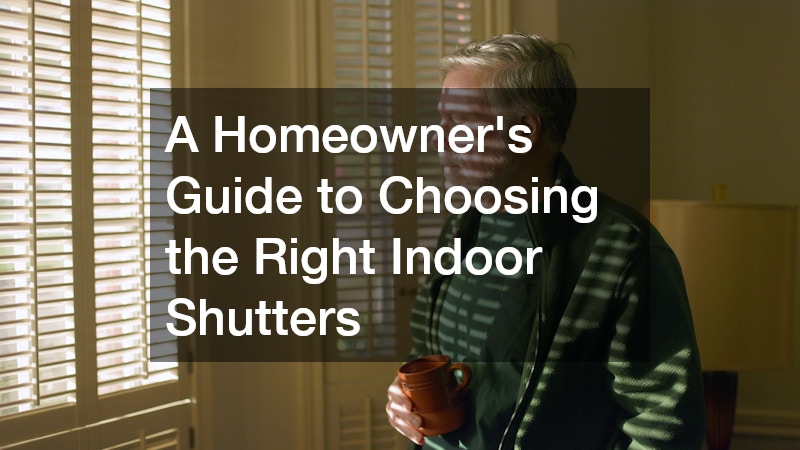Choosing the right window treatments is about more than just aesthetics. The materials, design and function all play a key role in achieving the right balance of privacy, light control and long-term value. For homeowners looking to upgrade, indoor shutters offer a reliable solution with both visual and practical benefits. This guide explores the main considerations when selecting shutters for your home, including materials, style options and installation tips.
Style & Function Go Hand in Hand
One of the key appeals of indoor window shutters is their ability to blend form with function. Unlike curtains or blinds, shutters become part of the architecture. They’re installed as permanent or semi-permanent features, giving them a more integrated appearance.
Before deciding on a style, consider the overall look of the room. Traditional homes tend to suit classic timber finishes, while modern interiors often benefit from sleeker composite options or neutral tones.
Adjustability is another important factor. Most indoor shutters feature tilt rods or hidden mechanisms that allow you to control airflow and light with precision. This flexibility is particularly useful in living areas, home offices and bedrooms where lighting needs can vary throughout the day.
Material Choices & Durability
The choice of material influences not just the look of your shutters but their performance and longevity. Timber remains a favourite for many homeowners due to its natural beauty and timeless feel. However, it does require more upkeep and is generally better suited to dry environments.
Composite materials, often made from PVC or engineered wood, offer an alternative that’s durable and low-maintenance. These are especially popular in areas exposed to moisture, such as kitchens and bathrooms. They resist warping, cracking and fading, making them ideal for high-traffic areas.
Aluminium shutters are another option for those wanting a sleek, industrial aesthetic. While more commonly used outdoors, they can be incorporated into interior spaces where robustness and security are priorities.
When choosing materials, always look at quality guarantees and warranties. Reliable manufacturers will offer extended coverage, giving you peace of mind over time.
Measuring & Installation Tips
Accurate measurement is essential to ensure a clean, professional finish. Most shutter systems can be mounted either inside the window recess or on the wall outside the frame, depending on the available space and desired appearance.
If you opt for inside mounting, ensure your window recess is deep enough to accommodate the frame and allow for full operation of the louvres. External mounting creates a bolder look and is ideal when the recess is too shallow or irregular in shape.
Although many suppliers offer DIY kits, professional installation is often the best route for achieving a flawless result. Skilled installers can account for uneven surfaces, tricky angles and unique architectural features that may not be obvious during initial planning. They’ll also ensure the shutters are level and securely anchored, which is vital for both aesthetics and functionality.
Maintenance & Cleaning Considerations
Another advantage of indoor shutters is their ease of maintenance. Unlike fabric curtains or textured blinds, shutters have smooth surfaces that don’t trap dust or allergens as easily. This makes them a popular choice for households with pets or family members who have allergies.
To keep them clean, simply wipe the louvres down with a damp microfibre cloth. For tougher grime, a gentle detergent mixed with water will usually do the trick. Avoid harsh chemicals or abrasive tools, particularly on timber or painted surfaces, as these can damage the finish over time.
Inspect moving parts like hinges and tilt rods regularly to ensure they remain in good working order. Minor adjustments can be done at home with basic tools, but if you notice consistent resistance or loose fittings, it may be worth calling a technician.
Matching Shutters to Interior Themes
Your shutters should complement, not compete with, your interior design. Neutral colours like white, beige or soft greys tend to work well with a wide range of decors. For bold spaces or feature walls, consider stained finishes or painted shutters in a matching tone to create visual harmony.
Customisation options like hidden tilt rods, arched tops or divided panels can help achieve a more tailored result. These features are particularly useful in heritage homes or architect-designed builds where attention to detail is critical.
Keep in mind that while it’s tempting to chase trends, choosing timeless designs will ensure your shutters don’t look dated in a few years. Simplicity often leads to longevity when it comes to permanent fixtures like window shutters.
Cost & Long-Term Value
While shutters may have a higher upfront cost than standard blinds or curtains, they often provide better value over time. Their durability means fewer replacements and repairs, while their insulating properties can help reduce heating and cooling bills.
In some cases, high-quality shutters can also boost a property’s resale appeal. Buyers are often drawn to homes with thoughtfully chosen fixtures that require little to no immediate upgrading.
When budgeting, factor in the cost of professional installation, customisation and any optional features. Get multiple quotes if possible, and always choose a provider that offers product guarantees and post-installation support.
By considering how each element, you’ll be better positioned to make a confident, informed choice. Investing in the right shutters today can lead to years of satisfaction and improved home value tomorrow.



